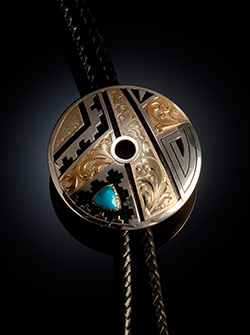
Explore the world of bolo ties, the uniquely Western sartorial adornment’s history and revival, in a new exhibition traveling to Gilcrease Museum this fall.
Native American Bolo Ties: Vintage and Contemporary Artistry, organized by the Heard Museum, Phoenix, Arizona, opens October 18, 2015 and runs through January 3, 2016.
The distinctive tie, named Arizona’s official state neckwear in 1971, originated in the Southwest, and its popularity quickly spread throughout the West and in many other parts of the country. The distinguishing necktie has been made even more distinctive by contemporary American Indian artists in Arizona who make bolo ties that are exquisite expressions of individuality and ingenuity.
Bolo ties, representing the casual nature and somewhat rugged milieu of the West, emerged as a form of men’s neckwear in the 1940s. They directly countered business suits as well as the formality that suits represented, marking a different style and a different way of life. In particular, American Indian jewelers and silversmiths brought individuality and creativity to this art form, offering a broad range of unique and artistic options.
The bolo ties included in the exhibition come from Chicago collector Norman L. Sandfield and from the Heard’s permanent collection of more than 170 bolo ties. Sandfield’s collection consists of more than 1,000 bolo ties, scarf slides and ephemera, many of which will be on display, as well as additional works from other private collections and museums.
A book written by exhibit curator Diana Pardue with Norman L. Sandfield and published by the Museum of New Mexico Press will be available for purchase in the Gilcrease Museum Store.
Native American Bolo Ties: Vintage and Contemporary Artistry shows the antecedents of the bolo tie including Victorian neckwear and scarf slides. It will include an important early scarf slide from the Heard Museum collection made between the 1930s-40s by Leekya Deyuse (Zuni Pueblo). The exhibit and book also include new information on patents for the different backings of the bolo tie, which is essential to accurate dating of a tie when the date is not otherwise known.
The exhibition examines how Western wear, including the bolo tie, was popularized through 1950s television shows and movies by well-known characters like the Cisco Kid, Hopalong Cassidy and Roy Rogers. The exhibit also showcases bolo ties created by American Indian jewelers from the late 1940s through today.